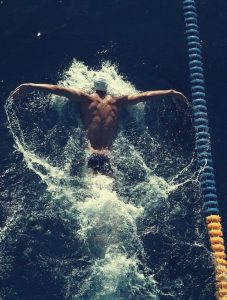Swimming is an invigorating and refreshing exercise that offers numerous health benefits. However, it’s not uncommon to experience muscle pain after an intense swimming session. In this article, we will talk about why does your muscle pain occur after swimming and provide you with effective techniques to relieve the muscle pain.
Why Does Muscle Pain Occur After Swimming?
Muscle pain, also known as delayed onset muscle soreness (DOMS), can occur after swimming or any intense physical activity. Understanding the causes behind this discomfort can help you better manage and prevent muscle pain after swimming. Here are some reasons why you may experience muscle pain after your swim:
Muscle Fatigue: Swimming is a demanding exercise that engages multiple muscle groups simultaneously. The repetitive motions and resistance provided by the water can lead to muscle fatigue. When your muscles are fatigued, they become more susceptible to micro-tears, inflammation, and soreness.
Lactic Acid Build-up: During intense exercise, including swimming, your muscles produce lactic acid as a byproduct of energy production. The accumulation of lactic acid can contribute to muscle soreness and stiffness. It’s important to note that lactic acid is not the direct cause of muscle pain, but its presence can indicate muscle tissue damage and inflammation.
Muscular Imbalance: Swimming primarily targets the upper body, including the shoulders, back, and arms. If you have muscular imbalances or weaknesses in these areas, the stress placed on specific muscles during swimming can lead to pain and discomfort.
Overexertion: Pushing yourself too hard during swimming or engaging in a more intense workout than your body is accustomed to can result in muscle pain. Overexertion can cause muscle strain, which is characterized by microscopic tears in the muscle fibers.
Insufficient Warm-up: Skipping warm-up exercises before swimming and neglecting to cool down properly afterward can contribute to muscle pain.
Incorrect Technique: Using improper swimming technique can place excessive strain on certain muscles, leading to pain and discomfort. Inefficient strokes or movements can result in overuse injuries and muscle imbalances.
Dehydration: Swimming is a physically demanding activity that can cause significant fluid loss through sweating. Dehydration can contribute to muscle cramps, fatigue, and increased susceptibility to muscle soreness.
How to Relieve Muscle Pain After Swimming ?
Relieving muscle pain after swimming involves a combination of rest, gentle stretching, and some self-care techniques. Here are steps you can follow:
Rest: Give your muscles time to recover. Avoid strenuous activities that might exacerbate the pain.
Hydrate: Drink plenty of water to stay hydrated. Dehydration can contribute to muscle cramps and pain.
Warm Shower or Bath: Taking a warm shower or bath can help relax your muscles and relieve soreness. You can also add Epsom salt to your bath for added relief.
Stretching: Perform gentle stretching exercises to improve flexibility and reduce muscle tension. Focus on the major muscle groups used in swimming, such as your shoulders, arms, and legs. Hold each stretch for 15-30 seconds and repeat several times.
Massage: Consider getting a massage from a professional or using a foam roller to target sore areas. This can help release muscle knots and improve circulation.
Over-the-Counter Pain Relief: Non-prescription pain relievers like ibuprofen or acetaminophen can help reduce pain and inflammation. Follow the recommended dosage and consult a healthcare professional if you have any concerns or specific medical conditions.

Ice or Heat: Applying ice packs to sore areas can reduce inflammation, while a heating pad or warm compress can relax tight muscles. Use ice for the first 48 hours and then switch to heat as needed.
Compression: Wearing compression garments can help reduce swelling and support muscle recovery. These are especially useful for leg muscles.
Proper Nutrition: Consume a balanced diet with enough protein to aid muscle recovery. Foods rich in antioxidants, like fruits and vegetables, can also help reduce inflammation.
Active Recovery: Engage in light, low-impact exercises like walking or gentle swimming to promote blood flow and help your muscles recover.
Stay Consistent: Be consistent with your recovery efforts. It may take a few days or even a week for the muscle pain to fully subside.
Prevent Future Pain: To prevent muscle pain in the future, ensure you have proper swimming technique and warm up before swimming. Gradually increase the intensity and duration of your workouts to allow your muscles to adapt.
If your muscle pain persists or worsens despite these measures, or if you experience severe pain or any unusual symptoms, consult a healthcare professional for a proper evaluation and treatment plan. They can provide guidance based on your specific situation.
Conclusion
After knowing the reason of the muscle pain, you may avoid and relieve muscle pain after swimming and ensure a more enjoyable and pain-free experience. If your muscle pain persists or worsens despite these measures, or if you experience severe pain or any unusual symptoms, consult a healthcare professional for a proper evaluation and treatment plan. They can provide guidance based on your specific situation.


